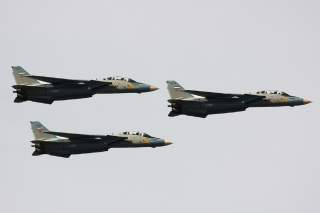Is Iran's Air Force Dying?
Recent events may suggest so.
Two incidents in late August 2018 involving Islamic Republic of Iran Air Force F-5F Tiger II fighter jets underscored the ongoing crisis in Iran’s air force.
On Aug. 21, Iran unveiled what it described as a new, fourth-generation fighter jet. Iranian president Hassan Rouhani even sat in the plane’s cockpit and posed for photographs.
One problem. The aircraft in question was conspicuously an F-5F, one of the 17 Iran bought from the United States during the rule of the Shah. It was not domestically-built.
“Iran has probably upgraded the electronics systems, originally from the 1960s, and made other upgrades,” Iran analyst Nader Uskowi suggested. “But it is not clear why the president of the country should unveil a 40-year-old plane as a new fighter.”
War Is Boring contributor Sebastien Roblin pointed out that Iran is in fact developing a new plane called the Kowsar-88, another in a long line of modified reverse-engineered F-5s that Tehran will either use as a trainer or light-attack aircraft.
But that jet “wasn’t ready for display this August, so Tehran simply took an old, very well-known jet fighter and claimed it was a new one, in full view of domestic and international audiences that would know better,” Roblin wrote at The National Interest.
Iranian efforts since at least 1997 to build what amount to modified F-5s have resulted in around a dozen operational aircraft. Iran’s promotion of an aged F-5F as a “new” fighter could well be a sign of desperation. Under renewed economic pressure from Washington, it appears Iran is demonstrating military strength any way it can.
Much of the IRIAF’s equipment dates back to the Shah era, or is left over from Saddam Hussein’s Iraqi air force, which flew many of its planes to Iran during the 1991 Persian Gulf War to avoid destruction. American-made F-4, F-5 and F-14 fighters dating from the 1970s remain the backbone of the Iranian air force.
Among the aircraft Iraq sent to Iran in 1991 were Soviet-vintage Su-22 Fitters. In July 2018, Tehran claimed 10 of the jets were being overhauled for continued service.
“After this overhaul, the bomber-fighters will be able to carry and use smart and pin-pointing cluster bombs, air-to-ground and air-to-air missiles and transmit data and information from drones from a several-kilometer distance,” claimed Gen. Amir Ali Hajizadeh, commander of the Islamic Revolutionary Guard Corps’ paramilitary air force.
Upgrading and improving third-generation aircraft makes some sense, especially given the fact that Iran can’t rely on outside sources for new airframes and spare parts. But even with upgrades, old planes can be dangerous to their pilots.
On Aug. 26, 2018, an F-5F suffered a double engine fire. Col. Manouchehr Fattahi made an emergency landing, but the impact killed him. His co-pilot managed to eject and survived. The plane remained largely intact and will likely fly again after repairs.
Nevertheless, the accident once again highlighted the IRIAF’s shortcomings. The faulty ejection seat that failed to save Fattahi’s life was supposed to be replaced 40 years ago.
After the 2015 nuclear deal, Iran had a brief opportunity to revamp its air force. Tehran briefly contemplated buying modern Mirage 2000 fighters from France but ultimately decided against it, logically concluding it was more familiar with American and Russian equipment.
Recommended: Forget the F-35: The Tempest Could Be the Future
Recommended: Why No Commander Wants to Take On a Spike Missile
Recommended: What Will the Sixth-Generation Jet Fighter Look Like?
Recommended: Imagine a U.S. Air Force That Never Built the B-52 Bomber
Iran also had a chance to buy as many as 30 sophisticated Su-30 fighters from Russia but opted not to. This is probably because the Iranian Islamic Revolutionary Guard Corps paramilitary has never been comfortable with the regular Iranian military becoming too powerful.
“We have a lot of weaknesses in the air force fleet,” one IRIAF major confided to Al-Monitor back in 2015. “Our fourth-generation fighters, such as the MiG-29, have not been upgraded to the SMT model, our F-14s are still ‘A’ models and our close-air-support planes, such as F-5 Tigers, are so old. The reality is that our enemies around the region have the most modern American and Russian warplanes. It’s clear that our air force needs new planes.”
Reza Pahlavi, son of the last Shah of Iran Mohammad Reza Pahlavi and a former F-5 pilot, took to Twitter to criticize the incumbent regime for its continued use of old planes. “Use of aged fighters which could have been retired and replaced by modern jets years ago is not only an indication of the regime’s incompetence but is a crime against our experienced pilots.”
This first appeared in WarIsBoring here.
Image: Creative Commons.

